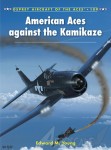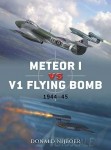Monday, July 02, 2012 - 05:17 AM UTC
Osprey Publishing have announced three new titles in their offer which should be available in sale in October 2012.
"American Aces against the Kamikaze"
Series: Aircraft of the Aces 109
Author: Edward M. Young
Illustrator: Mark Styling
Paperback
Publish date: October 2012
96 pages
ISBN: 9781849087452
About this book
The Japanese High Command realised that the loss of Okinawa would give the Americans a base for the invasion of Japan. Its desperate response was to unleash the full force of the Special Attack Units, known in the west as the Kamikaze (‘Divine Wind’). In a series of mass attacks in between April and June 1945, more than 900 Kamikaze aeroplanes were shot down. Conventional fighters and bombers accompanied the Special Attack Units as escorts, and to add their own weight to the attacks on the US fleet. In the air battles leading up to the invasion of Okinawa, as well as those that raged over the island in the three months that followed, the Japanese lost more than 7,000 aircraft both in the air and on the ground. In the course of the fighting, 67 Navy, 21 Marine, and three USAAF pilots became aces. In many ways it was an uneven combat and on numerous occasions following these uneven contests, American fighter pilots would return from combat having shot down up to six Japanese aeroplanes during a single mission.
Contents
"Meteor I vs V1 Flying Bomb 1944"
Series: Duel 45
Author: Donald Nijboer
Illustrators: Jim Laurier Gareth Hector
Paperback
Publish date: October 2012
80 pages
ISBN: 9781849087063
About this book
A total of 10,500 missiles were launched as part of the V1 attack, of which 3,957 were destroyed by the defences. Indeed, it could have been much worse, for by the end of the war the Germans had manufactured close to 32,000 flying bombs. The defences put forward to guard against the V1 were formidable – 23,000 men and women with their guns, radar and communications networks were installed on coastal sites. Squadrons of Britain’s newest Spitfires, the F XIVs, and Hawker Tempest Vs were kept at home to battle the new menace. Rushed into action in July 1944 to help counter the V1 threat, Britain’s Gloster Meteor I was the first jet fighter to enter RAF service. On 4 August the Meteor scored its first V1 victory. Having just closed in on a flying bomb, its officer squeezed the trigger but his guns jammed. Using the Meteor’s superior speed, he was able to overtake the missile and, using his wing tip, he tipped the craft over and sent it crashing into the ground. The interceptions between the V1 and Britain’s Gloster Meteor were historic, and ushered in a new era of aerial combat.
Contents
"Sopwith Camel" (picture of the cover page is not yet available)
Series: Air Vanguard 3
Authors: Jon Guttman Peter Bull
Illustrators: Harry Dempsey Simon Smith
Paperback
Publish date: October 2012
64 pages
ISBN: 9781780961767
About this book
An icon of World War I aerial combat, the Sopwith Camel was a superb dogfighter in the hands of a pilot who could master its vicious idiosyncrasies. The first British fighter to be armed with twin machine guns, the Camel packed a considerable punch and was highly successful, notching up a considerable number of aerial victories. The Camel was a remarkable aircraft, and one that could perform in a variety of roles, including as a ground strafer, a night fighter and a carrier-based fighter. As newer, higher performance aircraft types were introduced and began to eclipse it, the dominance of the Camel declined and losses mounted. Nevertheless, Camels appeared over battlefields throughout the war and beyond, notably in the Russian Civil War.
Contents
Please remember, when contacting retailers or manufacturers, to mention that you saw their products highlighted here - on AEROSCALE.
Series: Aircraft of the Aces 109
Author: Edward M. Young
Illustrator: Mark Styling
Paperback
Publish date: October 2012
96 pages
ISBN: 9781849087452
About this book
The Japanese High Command realised that the loss of Okinawa would give the Americans a base for the invasion of Japan. Its desperate response was to unleash the full force of the Special Attack Units, known in the west as the Kamikaze (‘Divine Wind’). In a series of mass attacks in between April and June 1945, more than 900 Kamikaze aeroplanes were shot down. Conventional fighters and bombers accompanied the Special Attack Units as escorts, and to add their own weight to the attacks on the US fleet. In the air battles leading up to the invasion of Okinawa, as well as those that raged over the island in the three months that followed, the Japanese lost more than 7,000 aircraft both in the air and on the ground. In the course of the fighting, 67 Navy, 21 Marine, and three USAAF pilots became aces. In many ways it was an uneven combat and on numerous occasions following these uneven contests, American fighter pilots would return from combat having shot down up to six Japanese aeroplanes during a single mission.
Contents
- Origins of the Kamikaze Force
- Importance of Okinawa
- The April Battles
- Desperation - The May Battles
- The Final Battles
- VC Squadrons and the Fleet Air Arm
- APPENDICES
"Meteor I vs V1 Flying Bomb 1944"
Series: Duel 45
Author: Donald Nijboer
Illustrators: Jim Laurier Gareth Hector
Paperback
Publish date: October 2012
80 pages
ISBN: 9781849087063
About this book
A total of 10,500 missiles were launched as part of the V1 attack, of which 3,957 were destroyed by the defences. Indeed, it could have been much worse, for by the end of the war the Germans had manufactured close to 32,000 flying bombs. The defences put forward to guard against the V1 were formidable – 23,000 men and women with their guns, radar and communications networks were installed on coastal sites. Squadrons of Britain’s newest Spitfires, the F XIVs, and Hawker Tempest Vs were kept at home to battle the new menace. Rushed into action in July 1944 to help counter the V1 threat, Britain’s Gloster Meteor I was the first jet fighter to enter RAF service. On 4 August the Meteor scored its first V1 victory. Having just closed in on a flying bomb, its officer squeezed the trigger but his guns jammed. Using the Meteor’s superior speed, he was able to overtake the missile and, using his wing tip, he tipped the craft over and sent it crashing into the ground. The interceptions between the V1 and Britain’s Gloster Meteor were historic, and ushered in a new era of aerial combat.
Contents
- Introduction
- Chronology
- Design and development
- The strategic situation
- Technical specifications
- The combatants
- Combat
- Statistics and analysis
- Aftermath
- Bibliography
- Glossary
"Sopwith Camel" (picture of the cover page is not yet available)
Series: Air Vanguard 3
Authors: Jon Guttman Peter Bull
Illustrators: Harry Dempsey Simon Smith
Paperback
Publish date: October 2012
64 pages
ISBN: 9781780961767
About this book
An icon of World War I aerial combat, the Sopwith Camel was a superb dogfighter in the hands of a pilot who could master its vicious idiosyncrasies. The first British fighter to be armed with twin machine guns, the Camel packed a considerable punch and was highly successful, notching up a considerable number of aerial victories. The Camel was a remarkable aircraft, and one that could perform in a variety of roles, including as a ground strafer, a night fighter and a carrier-based fighter. As newer, higher performance aircraft types were introduced and began to eclipse it, the dominance of the Camel declined and losses mounted. Nevertheless, Camels appeared over battlefields throughout the war and beyond, notably in the Russian Civil War.
Contents
- Introduction
- Design and Development
- Technical Specifications and Variants
- Operational History
- Conclusion
- Bibliography and Further Reading
Please remember, when contacting retailers or manufacturers, to mention that you saw their products highlighted here - on AEROSCALE.
Click Star to Rate
Only 1 reader has rated this.
THIS STORY HAS BEEN READ 5,003 TIMES.
| Osprey Publishing Reviews | MORE |
| P-47 vs Ki-43 by Frederick Boucher | |
| P-40E Warhawk vs A6M2 Zero-Sen by Frederick Boucher | |
| Guadalcanal 1942-43 by Frederick Boucher | of 1 ratings, 100% found this helpful | |
| Ploesti 1943 by Frederick Boucher | of 1 ratings, 100% found this helpful | |
| Schweinfurt–Regensburg 1943 by Frederick Boucher | of 1 ratings, 100% found this helpful | |
| Do 17 Units of World War 2 by Frederick Boucher | of 1 ratings, 100% found this helpful | |
| Six-Day War 1967 by Michael Satin | of 2 ratings, 100% found this helpful | |
| F-105 vs MiG-17 by Frederick Boucher | of 1 ratings, 100% found this helpful | |
| XB-70 Valkyrie by Frederick Boucher | of 1 ratings, 100% found this helpful | |
| Zero Aces 1940-42 by Frederick Boucher | of 2 ratings, 100% found this helpful | |
| Spitfire VC vs A6M Zero by Frederick Boucher | of 1 ratings, 100% found this helpful | |
| Linebacker II by Frederick Boucher | of 1 ratings, 100% found this helpful | |
| CBI B-25 Units by Frederick Boucher | of 1 ratings, 100% found this helpful | |
| Hellcat vs Shiden by Frederick Boucher | |
| Air Combat Dogfights WWII by Frederick Boucher | of 1 ratings, 100% found this helpful | |










Comments